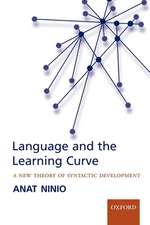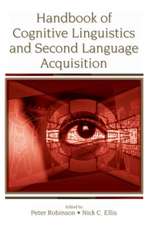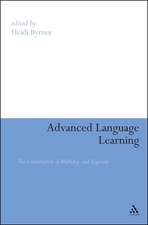Linguanomics: What is the Market Potential of Multilingualism?
Autor Dr Gabrielle Hogan-Brunen Limba Engleză Paperback – 8 feb 2017
| Toate formatele și edițiile | Preț | Express |
|---|---|---|
| Paperback (1) | 119.09 lei 43-57 zile | |
| Bloomsbury Publishing – 8 feb 2017 | 119.09 lei 43-57 zile | |
| Hardback (1) | 406.74 lei 43-57 zile | |
| Bloomsbury Publishing – 8 feb 2017 | 406.74 lei 43-57 zile |
Preț: 119.09 lei
Preț vechi: 129.69 lei
-8% Nou
Puncte Express: 179
Preț estimativ în valută:
22.79€ • 23.86$ • 18.86£
22.79€ • 23.86$ • 18.86£
Carte tipărită la comandă
Livrare economică 07-21 aprilie
Preluare comenzi: 021 569.72.76
Specificații
ISBN-13: 9781474238298
ISBN-10: 1474238297
Pagini: 184
Dimensiuni: 129 x 198 x 13 mm
Greutate: 0.23 kg
Editura: Bloomsbury Publishing
Colecția Bloomsbury Academic
Locul publicării:London, United Kingdom
ISBN-10: 1474238297
Pagini: 184
Dimensiuni: 129 x 198 x 13 mm
Greutate: 0.23 kg
Editura: Bloomsbury Publishing
Colecția Bloomsbury Academic
Locul publicării:London, United Kingdom
Caracteristici
Frank and factual exploration of the economic potential of multilingualism and monolingualism
Notă biografică
Gabrielle Hogan-Brun is at the University of Bristol, UK. She has written widely on language and education, with a particular focus on addressing and accommodating cultural and linguistic diversity in Central Eastern Europe.
Cuprins
AcknowledgementsSetting the Scene 1. Trading across cultures: Then and now Early trade and transportationMarkets and communicationTerritory, entrepreneurship, productionDemand, supply, resources2. Economic aspects of languages today Calculating language choicesAn economics perspectiveModelling multilingualismBalancing language choicesLanguage diversity economics3. Managing multilingualism Lessons from failuresBridging across languagesInvesting in human capitalHarnessing mobile resources4. Is learning another language worth it? Market incentivesLanguage beliefsLanguage choicesEmployment prospects5. Languages in the marketplace Multilingual workplace practicesLanguage services marketsLanguage teaching industryHeritage and language tourismNew languages, new marketsAfterwordNotes Glossary References Index
Recenzii
Hogan-Brun is on a mission to convince her readers that they should be more alert to the market [and social] potential of language learning ... [and] this is a laudable aim ... Linguanomics asks worthwhile questions.
[Linguanomics] offers the reader a broad and varied picture of the interplay and interconnection of economy and multilingualism. Hogan-Brun's conviction that society can benefit from language diversity is well-based on a plethora of data and examples that make the book an interesting and informative reading.
Hogan-Brun's book is a lucid introduction to the commodification of language, the various factors and processes which impinge on the market and exchange values of languages ... [A] carefully constructed text.
Due to its highly accessible style, Linguanomics by Gabrielle Hogan-Brun should appeal to a heterogeneous audience: lay people, policy makers, students and academics are sure to find food for thought within [its] pages . The author succinctly points out the various perspectives one can take on the economics of multilingualism and her descriptions are rich in illustrative examples taken from a diverse range of online and offline sources. The scope of the book is ambitious and as such it provides a much needed introduction to the economic issues of multilingualism.
The main merit of this book [...] is to raise different relevant questions, as well as to increase awareness of the importance of better understanding the relationship between multilingualism and the economy.
Gabrielle Hogan-Brun has conducted much research into multilingualism, its history, how people respond to new linguistic cultures, and the costs and benefits of incorporating multilingualism into business matters.
With cities like London now counting 300 languages among their residents, the globalization of trade, and empirical evidence of the cognitive value for young and old of bilingualism, one might wonder why one needs to argue for the learning and teaching of languages. But there is clearly such a need, and Gabrielle Hogan-Brun provides a lively, readable and wide-ranging survey of the value of multilingualism to individuals and nations.
In this succinct yet comprehensive book, the author provides a dispassionate account of the relationships - both historical and contemporary - between multilingualism and economics. Readers will find here an excellent source of information bearing upon both the benefits and the costs of linguistic diversity.
[Linguanomics] offers the reader a broad and varied picture of the interplay and interconnection of economy and multilingualism. Hogan-Brun's conviction that society can benefit from language diversity is well-based on a plethora of data and examples that make the book an interesting and informative reading.
Hogan-Brun's book is a lucid introduction to the commodification of language, the various factors and processes which impinge on the market and exchange values of languages ... [A] carefully constructed text.
Due to its highly accessible style, Linguanomics by Gabrielle Hogan-Brun should appeal to a heterogeneous audience: lay people, policy makers, students and academics are sure to find food for thought within [its] pages . The author succinctly points out the various perspectives one can take on the economics of multilingualism and her descriptions are rich in illustrative examples taken from a diverse range of online and offline sources. The scope of the book is ambitious and as such it provides a much needed introduction to the economic issues of multilingualism.
The main merit of this book [...] is to raise different relevant questions, as well as to increase awareness of the importance of better understanding the relationship between multilingualism and the economy.
Gabrielle Hogan-Brun has conducted much research into multilingualism, its history, how people respond to new linguistic cultures, and the costs and benefits of incorporating multilingualism into business matters.
With cities like London now counting 300 languages among their residents, the globalization of trade, and empirical evidence of the cognitive value for young and old of bilingualism, one might wonder why one needs to argue for the learning and teaching of languages. But there is clearly such a need, and Gabrielle Hogan-Brun provides a lively, readable and wide-ranging survey of the value of multilingualism to individuals and nations.
In this succinct yet comprehensive book, the author provides a dispassionate account of the relationships - both historical and contemporary - between multilingualism and economics. Readers will find here an excellent source of information bearing upon both the benefits and the costs of linguistic diversity.

















